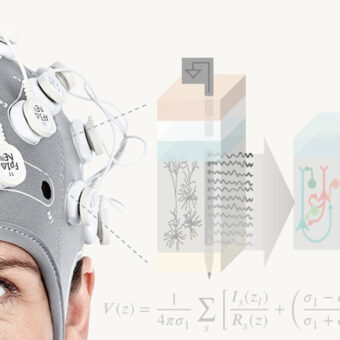If you are interested in Neuroscience, I am sure you have heard the term event-related potential. My objective in this post is to provide you with an introduction to this widely used neuroscience technique.
In order to do so, let me first categorise EEG recordings in two groups:
- Spontaneous EEG: the subject can have his/her eyes open or closed, perform a task (watching a movie, sleeping, …) or just do nothing at all. The recorded EEG is then analysed with the standard EEG processing steps, that I will explain in a further post coming soon.
- Event-related Potential: The subject has his/her EEG recorded, but in this case a series of repetitive stimuli are presented to him/her. These stimuli can be visual, auditory, tactile and even olfactory and gustatory.
The key question in a study on event-related potential is the averaging: we cut the EEG signal after each stimuli presentation, and we average all these epochs. That way we cancel out the intrinsic EEG noise and the important information survives, increasing the signal to noise ratio. We end up having a waveform with several peaks (i.e. potentials) that have a neurophysiological origin: our neurones synchronise and fire together in response to these external stimuli (event-related).
A very important characteristic of most event-related potential recordings is that the stimuli presentation needs to be very accurately synchronised with the EEG recording device, usually by means of a cable that sends a trigger to the EEG recording device each time a stimuli is presented. If the triggers are properly recorded along with the EEG signal, it is easy to automatically cut the signal in epochs for further averaging.
Let’s see the more common event-related potential techniques in more detail:
Steady state visual evoked potential (SSVEP)
Probably the simplest event-related potential. The subject is staring at a screen that is flickering at, let’s say, 20 Hz. The EEG recorded in the occipital electrodes, where visual information is processed, will present a 20 Hz oscillation and also oscillations at multiples of 20 Hz, called harmonics. In SSVEP, you don’t need any synchronisation between the stimuli presentation and the EEG recording device, since there is no averaging to be done. This technique has been widely used in brain-computer interfaces, since it’s easy to detect the different flickering frequencies the subject might be looking at in real time , thus allowing the user to control the movement of the mouse pointer on the screen, for instance.
Mismatch negativity (MMN)
this technique is usually studied for visual or auditory stimuli, and is based on the odd ball paradigm. A sequence of standard stimuli are presented to the subject (a sound for instance). From time to time, a deviant sound (different pitch, loudness and/or duration) is presented. The brain reaction to this deviant sound is a negative wave of about 200 ms (the so-called MMN wave) and a positive one of about 300 ms (also known as P300, see below) after the stimuli presentation (see image below for further clarification). One interesting fact about the MMN is that the subject under study does not need to be paying attention to the stimuli. The MMN will appear even if the subject is reading or watching a silent movie with subtitles. In other words, the MMN is an unconscious reaction of our brain to external stimuli. It seems that evolution has made our brain to be aware of strange noises. For sure this has been an important survival advantage for us, when our ancestors were in the middle of the jungle and suddenly a strange sound (i.e. a lion roar) made them run far or climb a tree.
MMN waveform. The stimuli are presented at t=0 msec. Extracted from: Light, G. A. et al. (2010). EEG and ERPs with human participants. Current protocols in neuroscience editorial board Jacqueline N Crawley et al, Chapter 6(July), Unit 6.25.1-24. John Wiley & Sons, Inc. with the permission of the author.
P300
The principle of the P300 is similar to the MMN, since it is also based on the oddball paradigm. Actually, P300 means positive wave of about 300 ms after the deviant stimuli is presented. The P300 is also associated with surprise, and it has been widely used in brain-computer interface applications. For instance a grid of flashing letters are presented to the user. The user fixes his/her attention on a specific letter he/she wants to spell. Each time the letter flashes, a P300 is recorded, and thus the computer can recognise which letter the user was spotting. This technique has allowed lock-in patients to communicate with the world, and it is considered the fastest brain-computer interface application in terms of bit rate.
Brainstem auditory evoked potential (BAEP)
This is an example of a clinical application of event-related potential. Its mechanism is quite simple. A series of repetitive auditory stimuli (clicks) are presented to the subject. By averaging the brain response after all of these stimuli, we obtain the BAEP waveform which consist of up to 7 peaks. These positive peaks are associated with different parts of the auditory system, and which allows this technique to detect hearing problems. Moreover, it can be used with newborn children so that hearing problems can be detected at a very early age.
As mentioned earlier, tactile, olfactory and gustatory event-related potential also exists. The principle is very similar to the P300 or MMN techniques: an odd ball paradigm is often used. For instance, a subject can have his EEG recorded while being touched on the hand repeatedly and from time to time the intensity of the touch would vary. A P300 should be detected after performing the averaging.
All in all, event-related potentials are often used as a cognitive research tool, and there are also clinical (BAEP) and a brain-computer interface applications (P300). Event-related potentials were discovered around 1935 and they are still widely used. I am sure they will be around for a long while…
photo credit: digitalbob8 via photopin cc




